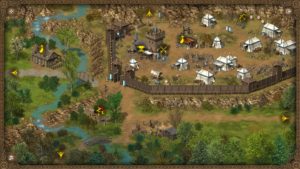Hero of the Kingdom series
 Every once in a while, someone writes a game that isolates a single feature found in more elaborate games and makes an entire game out of just that. The “Hidden Object” genre is perhaps the most familiar example. Hero of the Kingdom, a series of three shortish casual-positioned games in the heroic fantasy genre, is another. Hero of the Kingdom starts with the sort of resource management system familiar from RPGs like World of Warcraft: gathering, crafting, bartering. And it just sort of pares away the rest of the RPG.
Every once in a while, someone writes a game that isolates a single feature found in more elaborate games and makes an entire game out of just that. The “Hidden Object” genre is perhaps the most familiar example. Hero of the Kingdom, a series of three shortish casual-positioned games in the heroic fantasy genre, is another. Hero of the Kingdom starts with the sort of resource management system familiar from RPGs like World of Warcraft: gathering, crafting, bartering. And it just sort of pares away the rest of the RPG.
Oh, sure, there’s monster-slaying too, but monster-slaying is made into just another sort of resource collection, mechanically identical to fishing or gathering herbs. Any of these activities will have certain resources that it requires, and certain resources that it consumes. To catch a fish, for example, requires a fishing rod and consumes bait. Hunting a deer might require a bow, and consume a couple of arrows and some “Strength”, which is a resource produced by resting and consuming food. Slaying an ogre might require a sword and a certain level of Combat Skill, as well as consuming some Strength and a healing potion or two, but it’s still just a matter of exchanging resources for a reward. In particular, it is impossible to lose fights in these games. If you have the necessary resources, you will win. If you do not, you will not be allowed to engage the enemy at all. And the resources needed are quite specific, too. There are various weapons you can obtain, but they’re not the slightest bit interchangeable; if an enemy requires a sword, a spear is no more useful against it than it would be for picking berries or chopping firewood.
There’s a card-game-like abstractness to all this, but that ignores the exploration aspect. The whole thing takes place on a network of lavishly-illustrated isometric landscapes, with various of the joining paths blocked by monsters. Most actions are performed by clicking icons superimposed on this world, although a few of the more primitive activities, such as searching for mushrooms, are done hidden-object style. The peculiar thing about this is that the player has no avatar on the screen. It’s not the disembodied-presence approach of a Samorost, either. It’s clear that you’re controlling a player character with a presence in the world, because NPCs will address you and say things like “That was amazing, I’ve never seen such skilled fighting!” after you click on an orc. Your character just isn’t displayed with everyone else.
The three games (so far) in the series use this system to tell different stories, albeit all ones that fit the usual parameters of heroic fantasy games. The plot is all about building up your power (that is, wealth) to defeat increasingly fearsome foes until there’s none left and you win. Mechanically, though, it’s largely about denuding the gameworld of its natural resources. The third game changes things up a bit by respawning stuff after a while, but in the first two, the total amount of everything you can find is simply finite, so areas you’ve already plundered are exhausted forever, while any new areas you open up are ripe for the picking. Talk about implicit colonialist attitudes.
Anyway, it’s a series that’s worth looking at just because there’s nothing else quite like it. Possibly the closest thing is the 12 Labours of Hercules series and its ilk, which have a similar monsters-as-obstacles-requiring-resource-gathering approach. But those are hectic races against time in a cartoony style, and Hero of the Kingdom couldn’t be farther from that.
 Comments(2)
Comments(2)